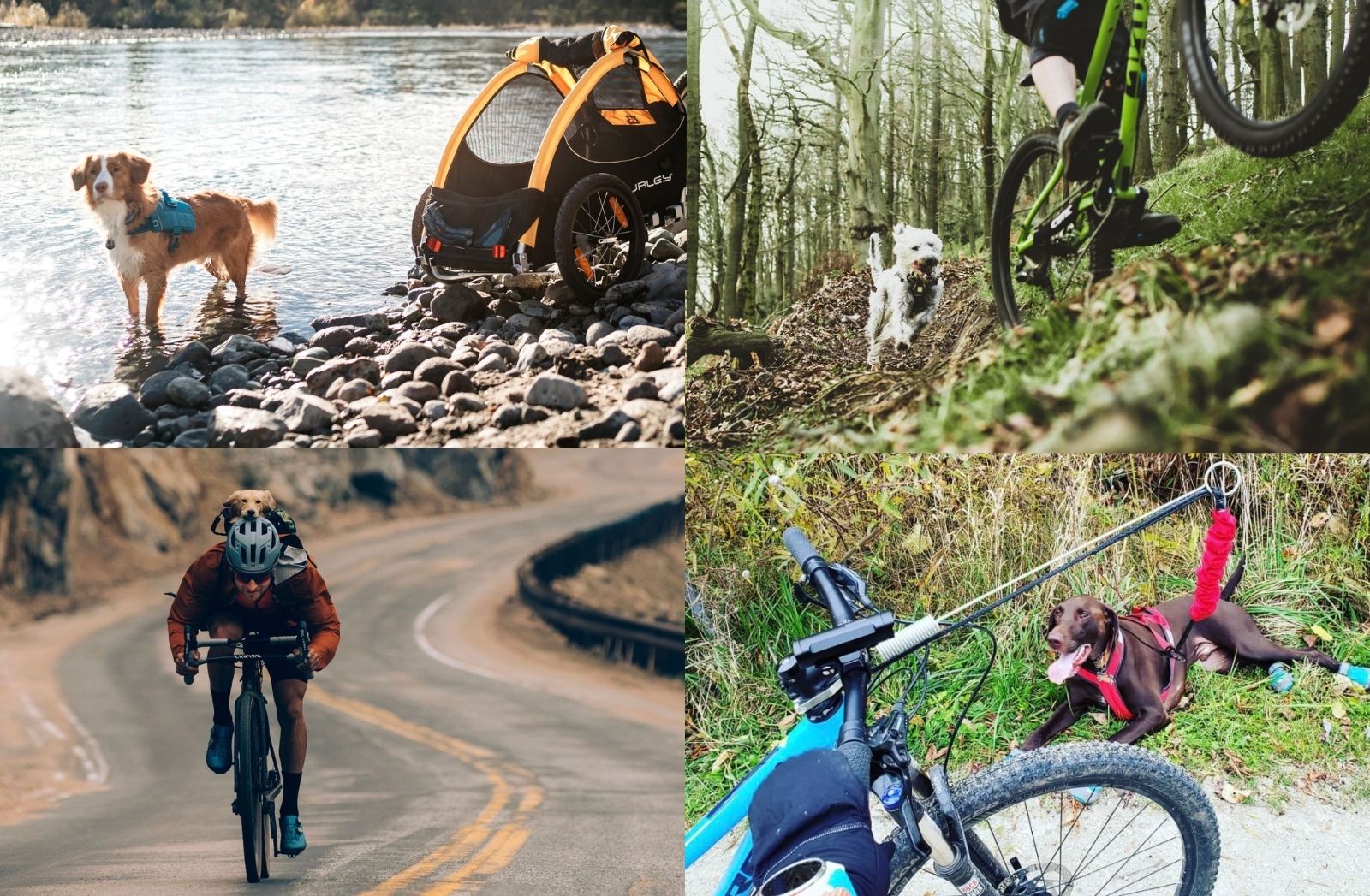If you’ve ever been on a ride and thought, “My dog would love this,” you’re not alone. Plenty of riders bring Fido along for the bike ride, whether it’s on singletrack or a casual spin to the cafe. And trail dogs come in all shapes and sizes.
But riding with your dog isn’t a simple task. It requires proper training, a well-behaved dog, and in most cases, some kind of specialty gear for maximum safety and enjoyment.
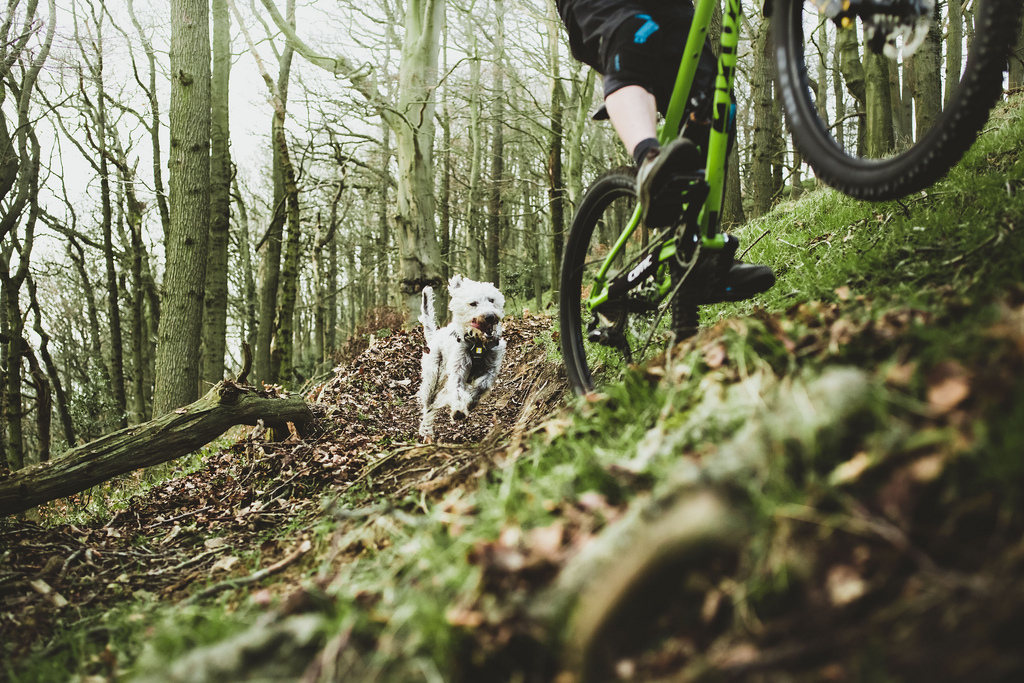
We’re not just talking about gear for trail dogs, though we have plenty of suggestions there. Many of us have pups who wouldn’t last a mile on singletrack, but we still want them along for some rides. We’ve added options for those who’d rather carry their dog by bike, whether cruising the neighborhood or going on a bikepacking adventure.
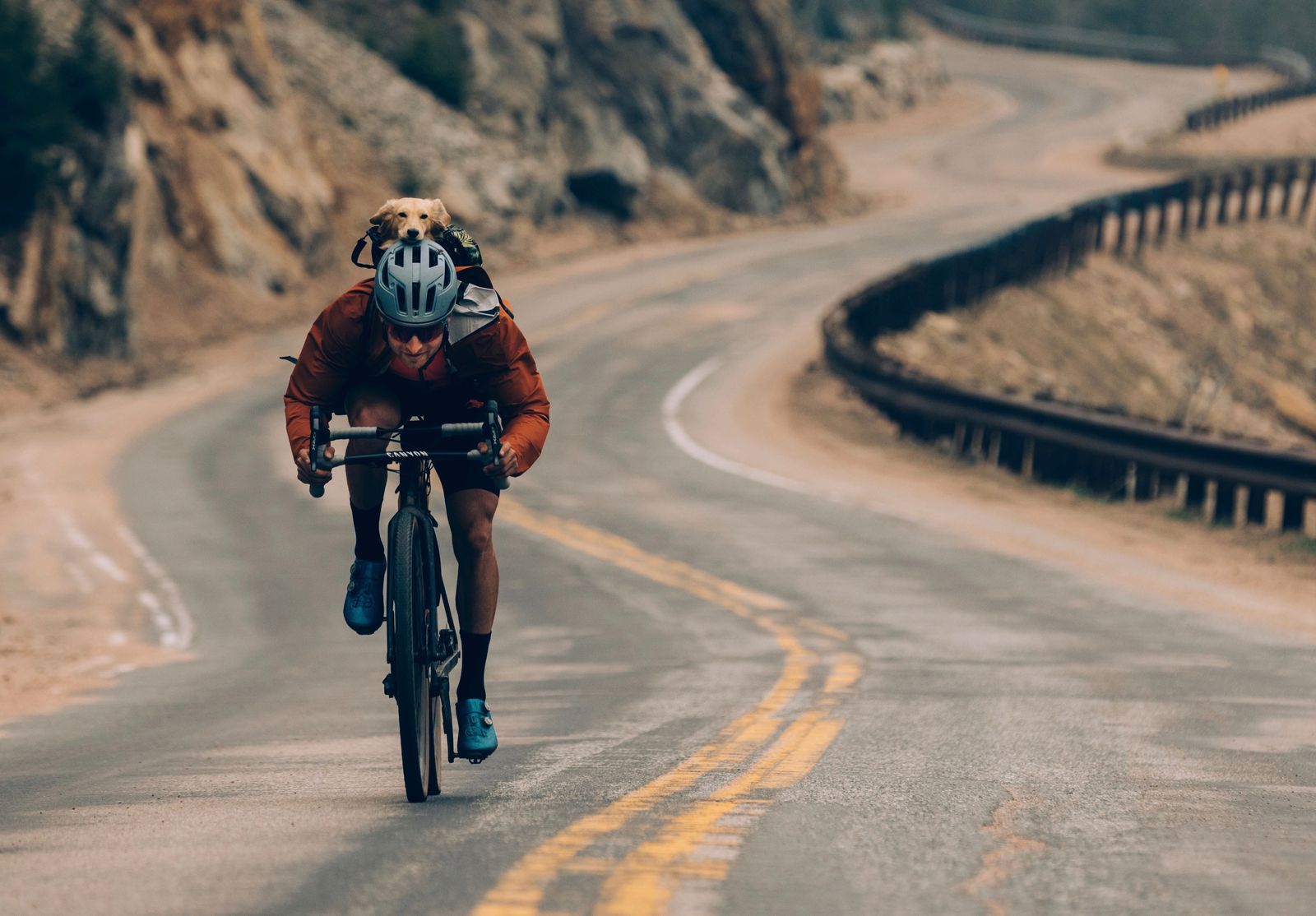
How to ride bikes with your dog
Typically, we’d reserve the advice section for the end of the article, but we wanted this to be prominently displayed. If you are planning on bringing your dog along for an off-leash romp beside your mountain bike, there are a few important caveats:
- Make sure you’re allowed to have your dog off-leash in the area you’re planning to ride. Many places don’t allow off-leash dogs—be respectful of those rules.
- Your dog should be able to easily follow voice commands and always respond when you call him or her. Whether you’re using the dogjoring-style leash we recommend or going off-leash, start slow. Train your dog to run with you on the bike somewhere where there aren’t people, other dogs, or distractions, like a big open field. Eventually add stimulus, like another mountain bike or even another (already trained) trail dog, and make sure you both feel completely comfortable before hitting the trails.
- You might love dogs, but remember that not everyone does. Be aware of other humans on the trail and don’t assume people are as happy to see your dog as you are. You should be ready to leash your dog at a moment’s notice.
- Be patient. Your dog might not be up for a 90-minute ride on its first jaunt, or you may find that you need to stop while he sniffs around or rolls in creeks.
- Be realistic. Some dogs simply aren’t going to want to ride in your handlebar basket or bike backpack, or chase you on trails. And some dogs—like breeds with flattened noses—aren’t good at running long distances, so being out on the trails may be dangerous for them.
- Mature dogs only, please. Both in behavior (they shouldn’t bolt at every squirrel) and age. Dogs should be at least a year old before hitting the trails with you. Puppies are still developing and letting them sprint after you on the bike can be dangerous to their development.
- Pay attention to your dog’s needs while you ride. Remember, they get hot easily, so make sure when you’re stopping to take a drink, you’re pouring some water for your pup as well. Or on them. Which means you need to bring extra water.
- And keep an eye on their paws. If you’re worried about your tires puncturing on sharp rocks, your pup’s paws are also at risk.
- Clean up after your dog. Always.
Now that that’s out of the way, let’s talk gear! (And scroll down to the bottom for more frequently asked questions.)
BEST TRAIL DOG HARNESS: Kurgo Stash ‘n’ Dash Harness
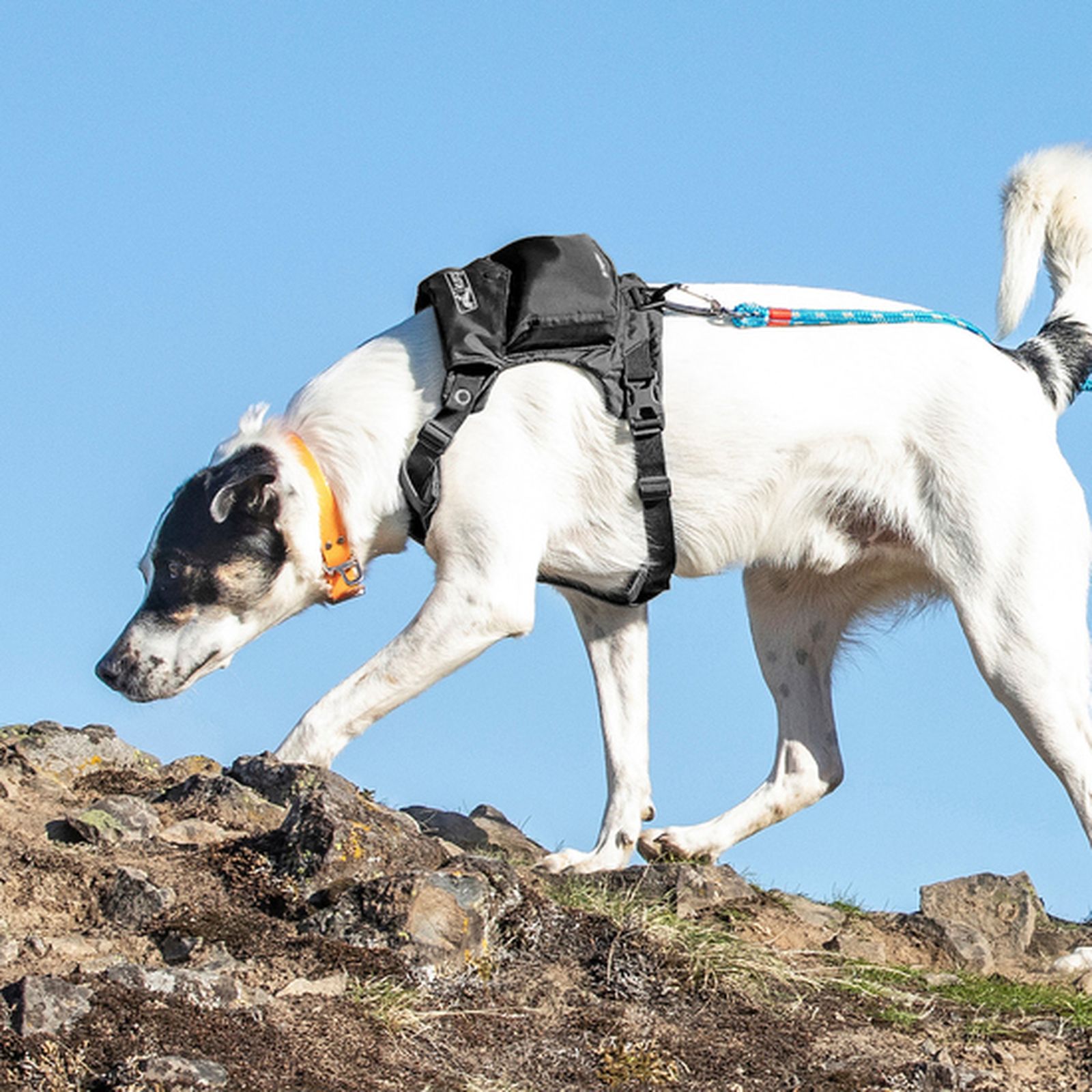
Swap your dog’s collar for a harness when going on any speedy adventures. Harnesses are easier on your dog’s neck and make controlling them safer. We like the Kurgo Stash ‘n’ Dash Harness because it’s small and can be—as its name implies—stashed in your hydration pack so that you never forget to bring it when heading out with your dog.
On the trails, if you have your dog off-leash (again, in an area where such a thing is allowed!), a harness allows you to easily snag him if he needs to be put back on the leash. Reflective accents make this harness particularly easy to spot on dawn patrol rides. This harness is also lightweight and breathable—important for hot weather jaunts.
- Type: All dogs
- Size: 5 harness sizes, from XS (5 pounds) to XL (110 pounds)
- Price: $38
PROS: Lightweight, inexpensive for a high-quality harness
CONS: Still requires some kind of leash to connect to the bike
BEST CLEANUP KIT: Bark and Ride Poo-chi Pouch Top Tube Bag
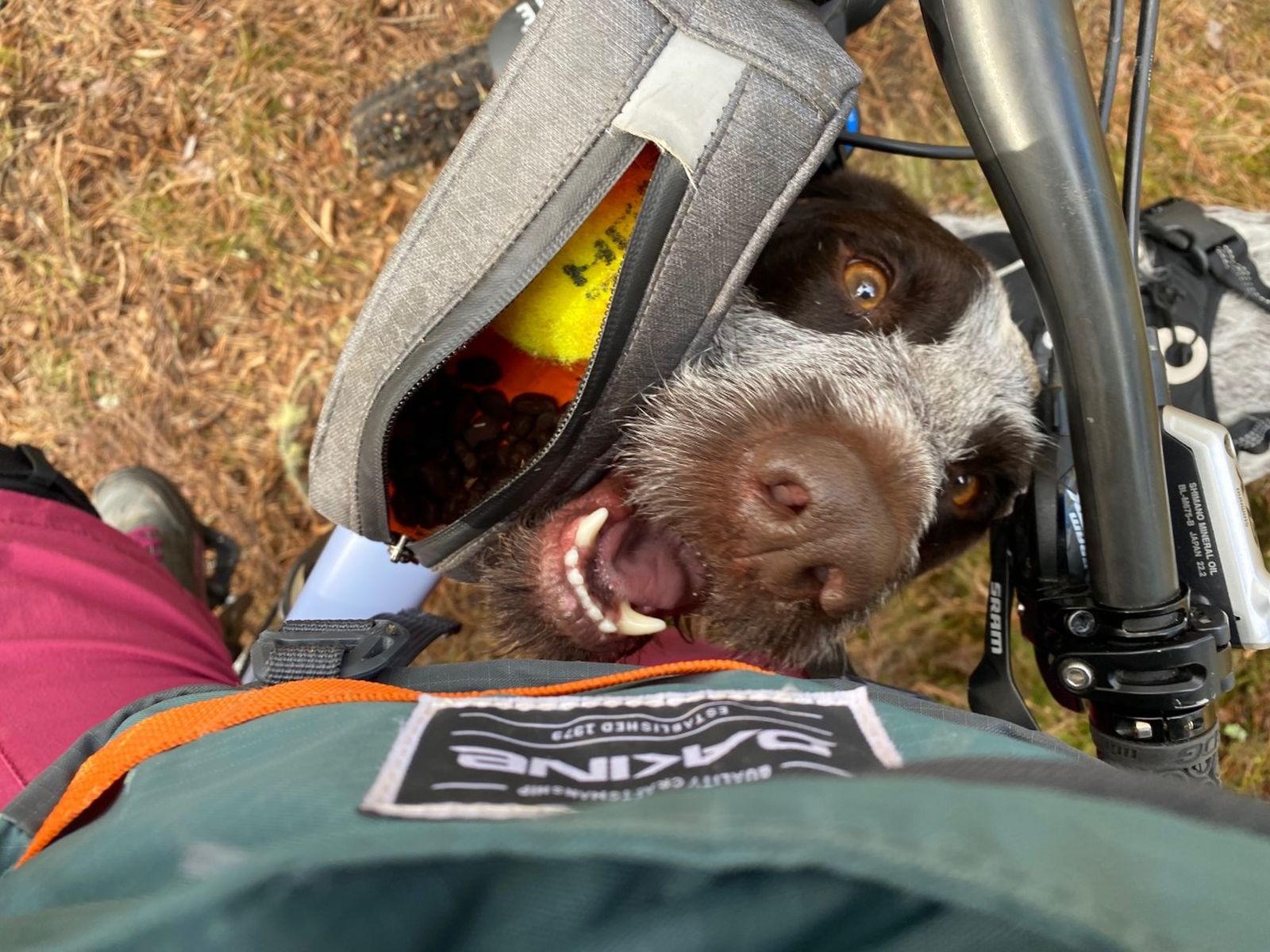
The Poo-chi Pouch Top Tube Bag is the perfect piece of kit to ensure that you and your dog are responsible on any adventure. Could you just stick a poo bag in your pocket? Sure. But we like this cute top tube bag since it has spots for poo bags (with an easy dispenser) as well as space for treats for you and your pup.
It’s water-resistant, has a reflective print, and can fit on any type of bike. In short, this inexpensive bag helps you remember to pick up after your dog, but it’s also useful for storing your essentials. And if you’re not bringing your pup on your ride, you can still use it to store your phone and snacks.
- Type: All dogs
- Size: One size
- Price: $29
PROS: Easy reminder to pick up poo, great for storing treats as well
CONS: Not strictly necessary
BEST FOR ON-LEASH RIDING: Nonstop Dogwear Biking Kit
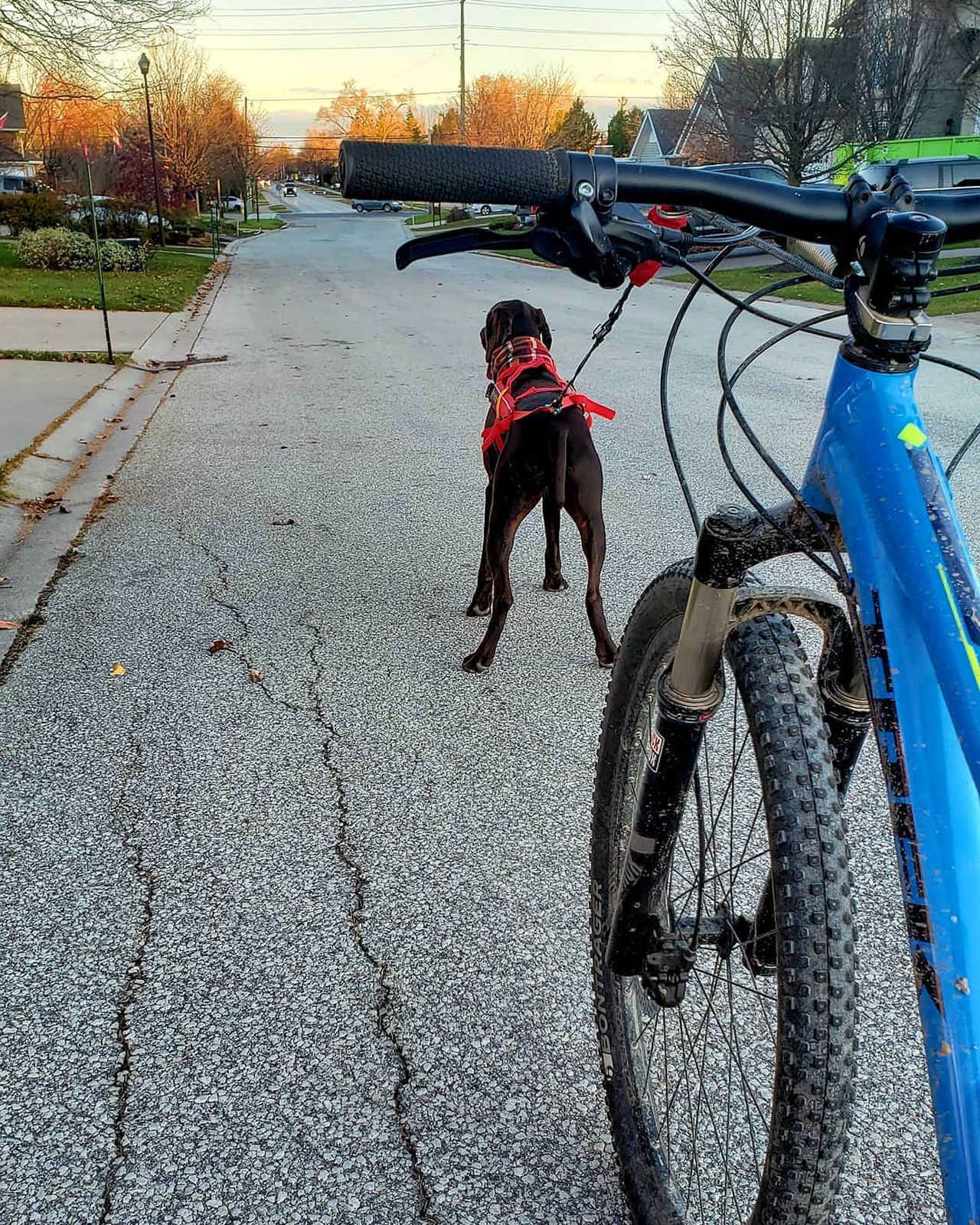
Dogjoring is where a dog pulls a sled, and bikejoring is the new skijoring. Longtime rider and runner Kate Ditullio’s German Shorthair Pointer Blitz is a speedy dog on and off the leash. In parks where leashes are required or for jaunts around town, she likes Nonstop Dogwear’s Biking Kit, which combines a Freemotion harness, bungee leash, and an antenna that connects it all to the bike.
Blitz is able to set the pace rather than get dragged alongside the bike thanks to an antenna that goes off the front of the bike rather than the side. The Freemotion harness is loose so it moves with the dog rather than stifling him. And a bungee cord leash provides more freedom without creating a tripping hazard.
Ditullio’s primary piece of advice: Make sure that your dog understands trail cues and is comfortable in the harness before ripping on singletrack. Blitz understands Left, Right, and Stop. Practice riding together in a field before heading onto the trails. Dogjoring won’t be for every dog, but if you want to bring your pup on your ride and keep him close, this kit is the best way to do so.
- Type: Trail dogs
- Size: 9 harness sizes, for 10.2 to 25.2-inch circumference dog necks
- Price: $200
PROS: Keeps dog safely attached to you
CONS: Not every dog will be suited for dogjoring, requires training and patience, expensive
BEST FOR OFF-LEASH TRAIL DOGS: SceneReal Large Collar Bell
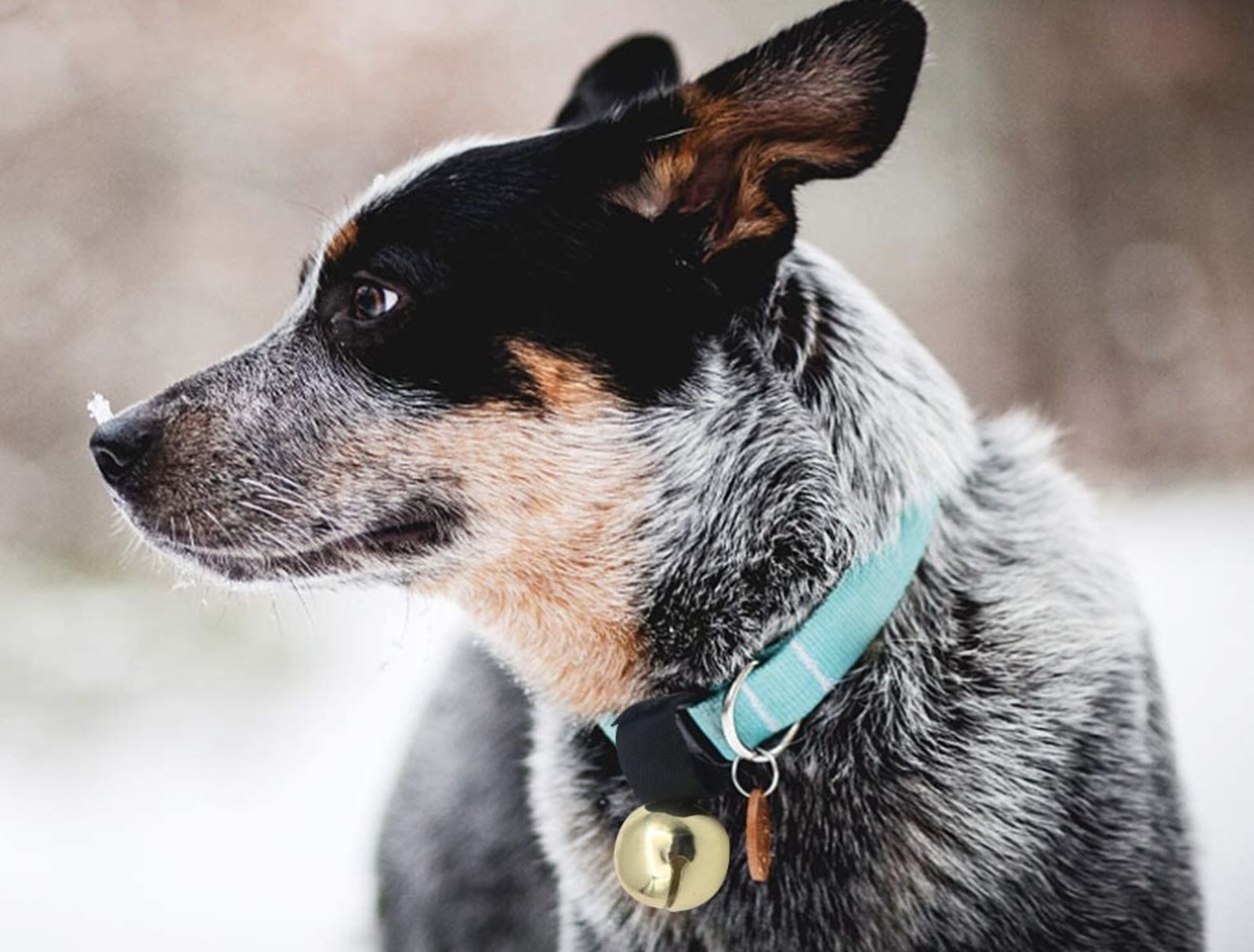
If you are in an area where your dog can roam free on the trail, a bell around his neck serves a couple of important purposes. First, it allows you to know when he’s getting farther away, as the bell gets quieter and quieter. Second, it warns other riders and trail users that a dog is coming up behind them. And third, if you have a big dog who can occasionally get confused for a bear or wolf, the bell lets people know that he’s harmless.
The SceneReal Large Collar Bell clips onto a dog’s harness or collar and merrily jangles as your pup romps through the woods. It also gives smaller forest animals a heads up that something bigger is coming. If your dog likes to “hunt” birds and squirrels, this will give them a fighting chance.
- Type: Trail dogs
- Size: All dogs
- Price: $12 for two
PROS: Easy to keep track of your dog
CONS: Noise can get annoying
BEST FOR BIKEPACKING: K9 Sport Sack Air 2
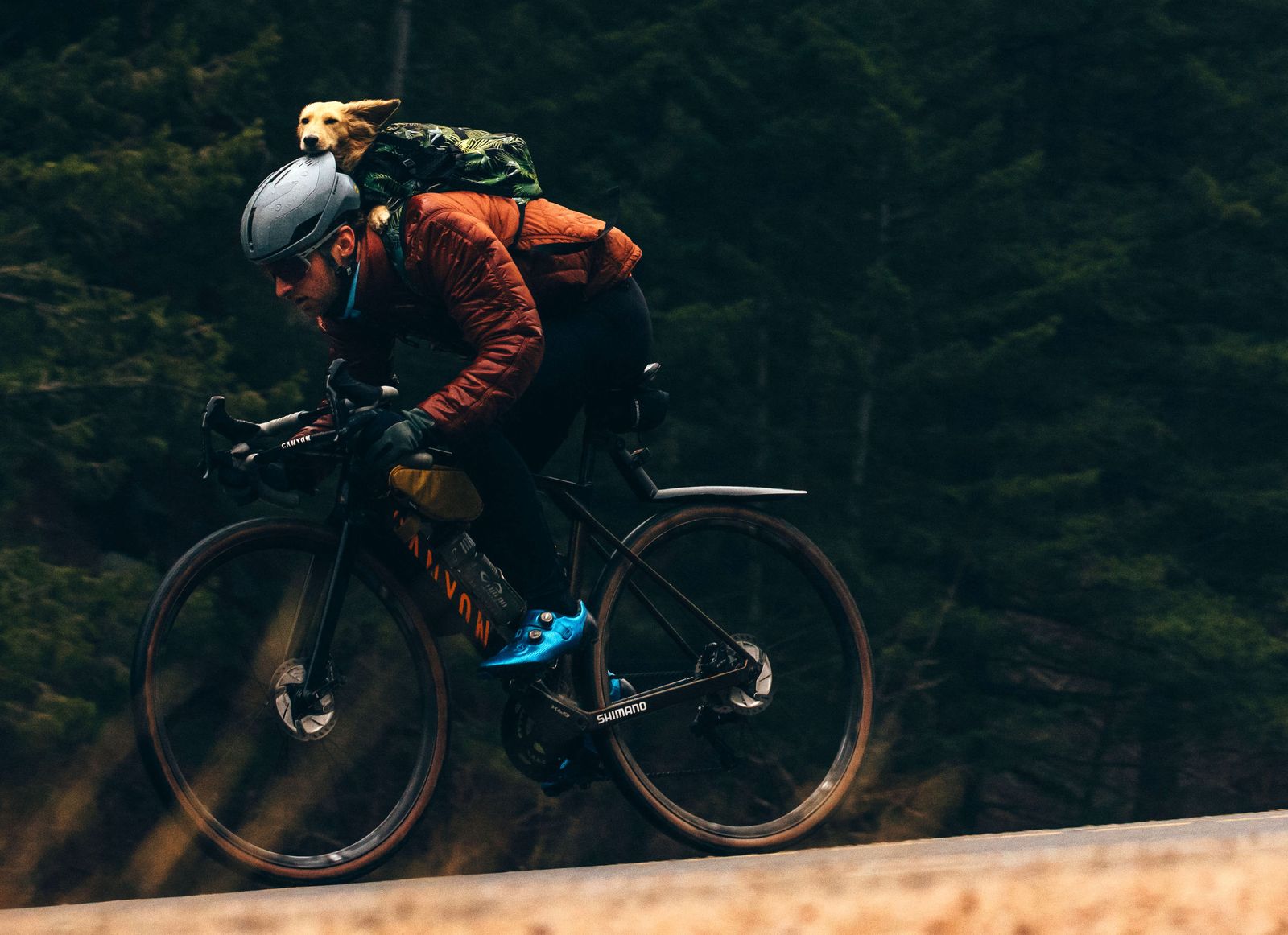
Pro racer Alexey Vermeulen wasn’t about to let his mini-dachshund’s short legs keep Willie from becoming the ultimate riding buddy. Rather than bringing him along on the trails, Vermeulen pedals for hundreds of miles with Willie comfortably nestled (and relatively aerodynamic) on his back.
This is a great option for road bikers and bikepackers who prefer to skip the basket on the front of their bike, and ideal for small dogs. The K9 Sport Sack Air 2 comes in sizes from extra small to large and can hold dogs up to 30 pounds in size. (There are burlier options if you relish the idea of riding with your golden retriever on your back, though we wouldn’t recommend it.) Practice on small rides, as a heavier load can throw your balance off.
The K9 Sport Sack Air 2 keeps even the wiggliest of pups in place and locked in when there are other animals in sight or bumps on the road. Vermeulen says Willie loves their rides together. They also bring the K9 Sport Snuggler—a winter coat for backpack pups—when they ride into the mountains in the event of inclement weather. (Follow Willie’s adventures on Instagram at @sirwilliethewiener)
- Type: Bikepacking / commuting
- Size: Dogs under 30 pounds
- Price: $75
PROS: Lightweight, comfortable for the rider
CONS: Dog may not like being in a backpack
BEST FOR OLDER + LAZIER DOGS: Burley Tail Wagon
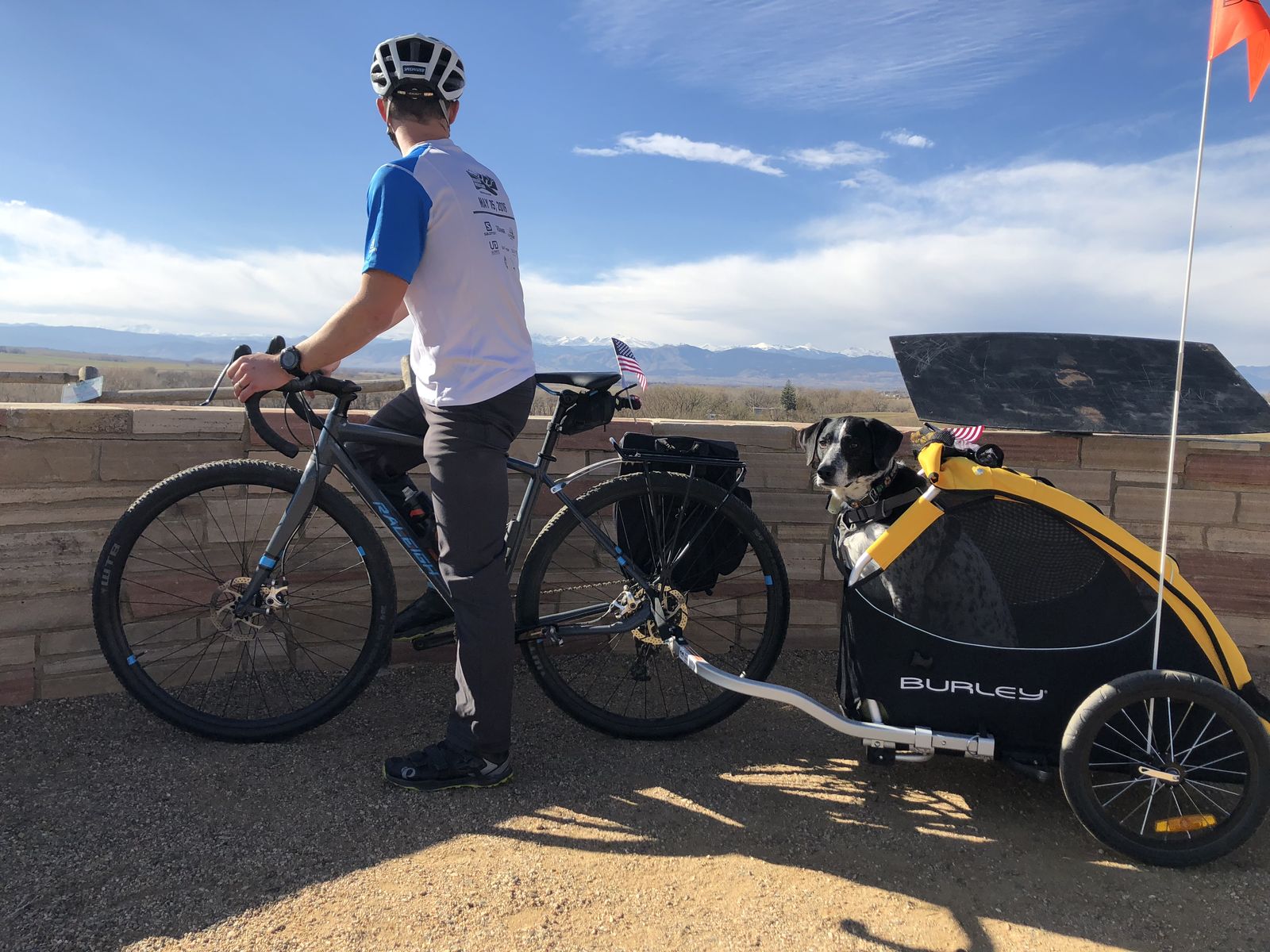
If you really love spending time with an older dog who simply is too big for a bike basket but too slow to plod alongside your bike, a chariot can help. We like the Burley Tail Wagon for its thoughtful design, lightweight towing, and ability to hold up to 75 pounds of pup. It’s a great bikepacker choice if you’re going longer distances with your dog, and depending on the size of your dog, it can hold some of your gear as well.
The Tail Wagon has a removable floor so it’s easy to clean. It has plenty of space for your dog to lie down, or to sit up with his head out to see what’s happening. It has mesh on all four sides for airflow to keep your dog cool, and a flip-down tailgate so elderly dogs don’t need to jump to get in and out. You can also purchase the stroller kit to convert it for walking or jogging.
It’s covered by a one-year warranty for fabric and a three-year warranty for all other parts. And when your dog isn’t using it, it’s handy for groceries.
- Type: Bikepacking/commuting
- Size: Dogs up to 75 pounds
- Price: $400
PROS: Great for older dogs who want to come along
CONS: Expensive
BEST FOR EMERGENCIES: Kurgo Blue First Aid Kit for Dogs
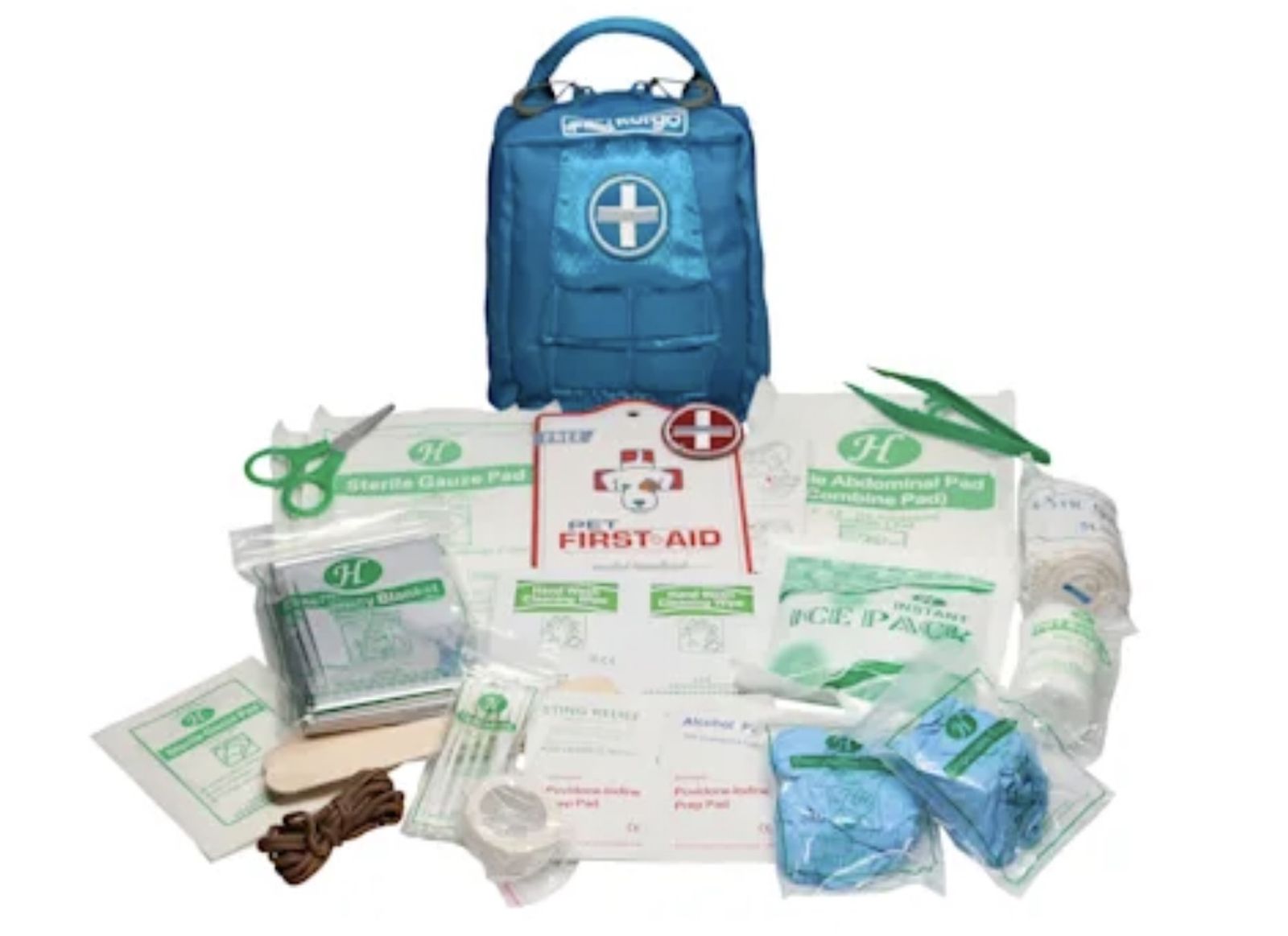
This 49-piece dog first aid kit closely resembles a regular first aid kit, but it’s packed with pup-oriented first aid supplies. You never know when your dog will step on a thorn, requiring tweezers and a gauze compress. A small first aid for pets booklet is included as well. There’s even an emergency blanket in there.
You may not want to bring it all in your bag: Things like a cold compress can be left behind. But having the essentials with you when you’re out can be helpful in an emergency. And honestly, all of the gear in here can double for human use as well, so it’s a good thing to keep with you on every ride.
Bonus: If you have a bigger dog and want him to carry his gear, this clips onto Kurgo harnesses!
- Type: All dogs
- Size: One size fits all
- Price: $33
PROS: Easy to carry, good for emergencies
CONS: Contains mostly first aid gear you probably already have at home
Trail Dog Gear Buyer’s Guide
Know your dog. Ask yourself how you want to ride with your dog, and what kind of playing your pup loves to do. If you have a very chill dog, he may not be an ideal candidate for a trail dog, but maybe he’d love to come along in a basket, backpack or chariot.
Think about your riding style. If you love spending all day on the trails, your dog might not be up for hours of running. But if you love quick spins in the forest, that might work perfectly. (Don’t forget to check leash laws!)
Think about your dog’s weight. Whether you’re pulling him in a chariot or being pulled in a dogjoring setup, make sure that you can handle his weight. Also check that the gear is rated for dogs of his size!
Measure twice. Use a soft tape measure to get accurate chest and neck sizes. Measure twice, buy once. And remember, just because your dog’s breed is listed as “size small usually fits XYZ breed,” it’s worth double checking. You may have a dog with a large chest for his breed. Weight also matters for things like bike baskets and chariots, so step on the scale with your dog and get an accurate reading.
Test before you ride. All of these pieces of gear can be tested in a field or parking lot without a bike in the mix. It’s worth spending a few practice sessions making sure the equipment fits your pup comfortably and they can follow orders before adding the bike.
Frequently Asked Questions About Bike Gear for Dogs
Can any dog be a trail dog?
Sure, some breeds are obviously better for running with your bike. Vizslas, German Short-Haired Pointers, Australian Shepards, and Border Collies are obvious choices, but sometimes, the tiny dogs can surprise you. Case in point, this tiny 8-pound Havanese just sending it. And check the video above to see more four-legged shredders in action.
Smaller dogs might not be able to go for long distances or fast rides, but they might enjoy short jaunts or more field-based family bike outings. (This editor’s mini-dachshund enjoys laps of a local dirt pump track.)
Any tips for getting a dog used to the trails?
Starting with a specific short loop of a local trail is a good way to get started. This way, you’re never far from your car in case your dog tires quickly. A trail that you know well makes for smoother navigation. And dogs are surprisingly good with learning loops, so you may find it’s easier for your pup to keep up.
What should I bring?
In addition to the gear itself, always have treats and extra water on hand. It’s also a good idea to carry a small pet first aid kit in your pack in case of emergencies. And of course, always have poo bags.
Keep an eye on the weather as well. If your dog is sitting in a carrier, he’ll get chilled from cold or wet weather more easily, so you may want to bring a jacket.
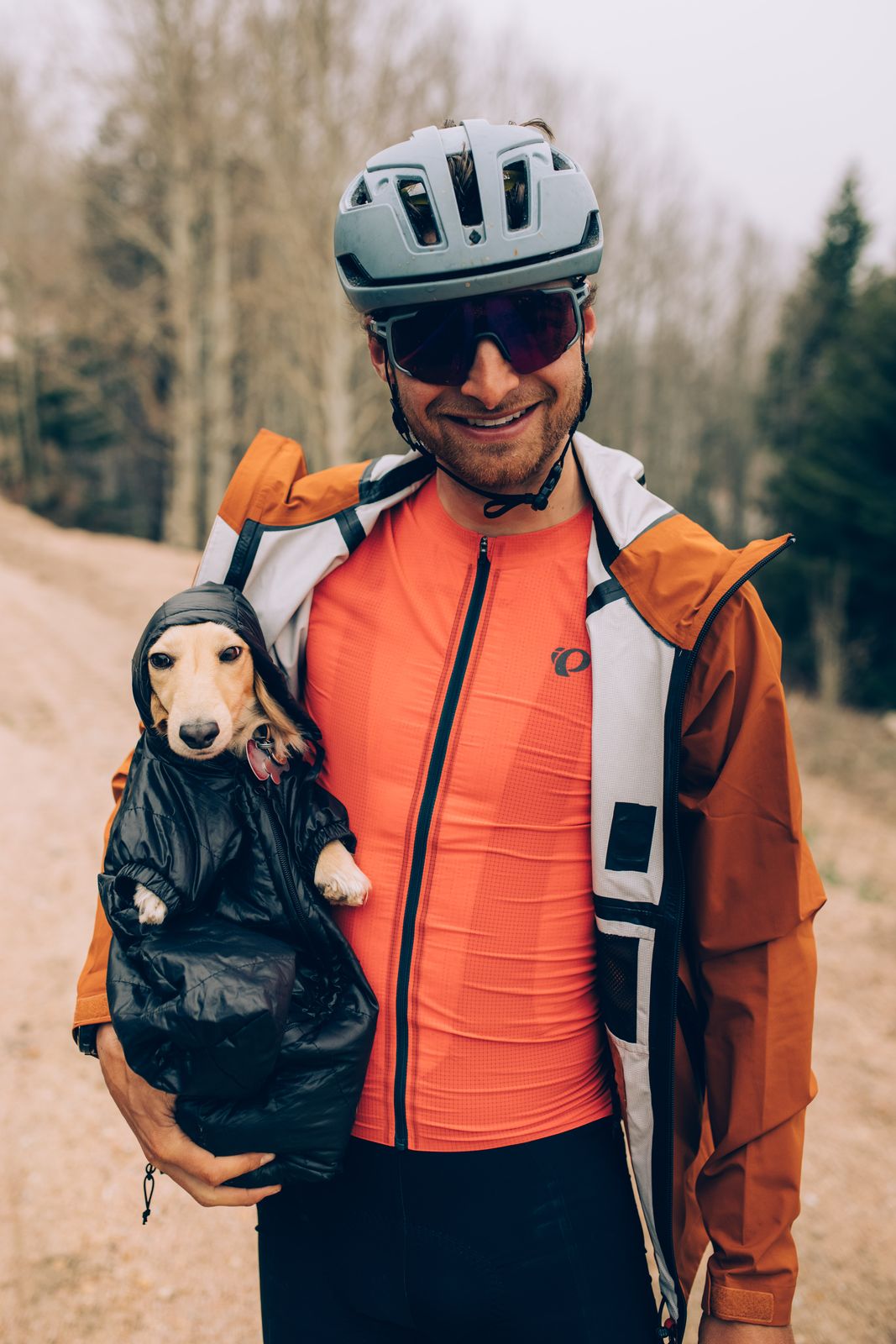
Do I need a pet-specific chariot?
You can repurpose most children’s trailers for your pup, but there are dog-specific trailer options that offer enough space for a dog to lie down and maximum breathability in their materials. A kid’s trailer will have seats, but a bit of retrofitting can make it comfortable for most dogs.
Of course, it’s a big spend, but if you’re torn between being able to go on bikepacking adventures or staying home with Fido, a chariot can help make those trips possible. This Bikerumor editor’s dad spent many miles toting the family’s aging retriever along towpaths and rail trails in her golden years, and she (and he) loved every mile they were able to spend together.
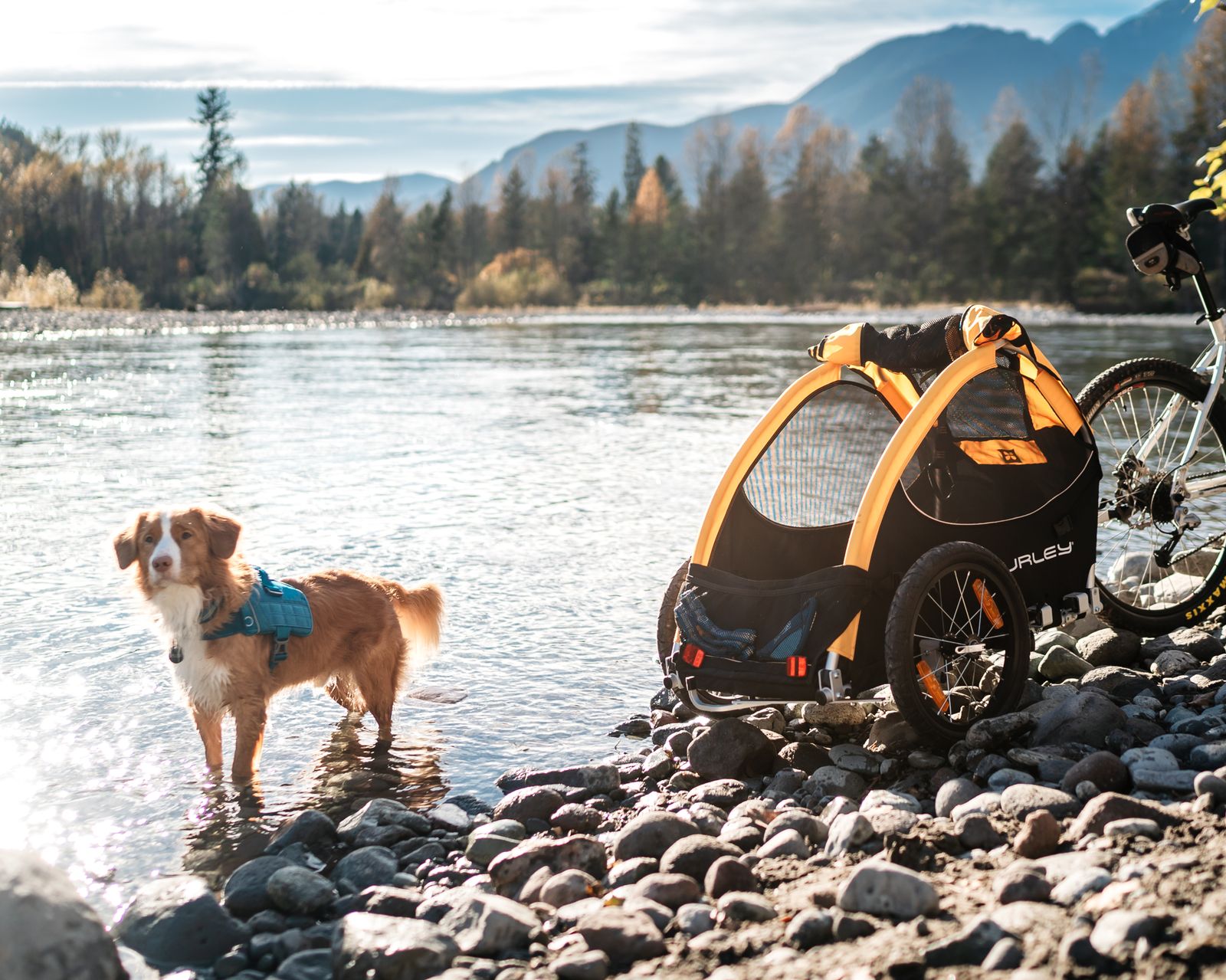
How do I get my dog used to a basket/bag/chariot?
Similar to getting your dog used to running beside your bike, start small. Even before putting your dog in the chariot and going for a short ride, bring the chariot inside and set it up as a comfy spot for your dog to explore. The same goes for baskets and bags. Then, gradually introduce movement by walking with the basket, bag, or chariot. Finally, hook it up to the bike for short durations. And make sure your dog gets plenty of treats or praise in the process!
Got your own tips for cycling with dogs? Let us know in the comments!
Disclosure: Some of these links are affiliate links that may earn a small commission for Bikerumor if you click on them and buy something. This helps support our work here without costing you anything extra. You can learn more about how we make money here. Thanks!
